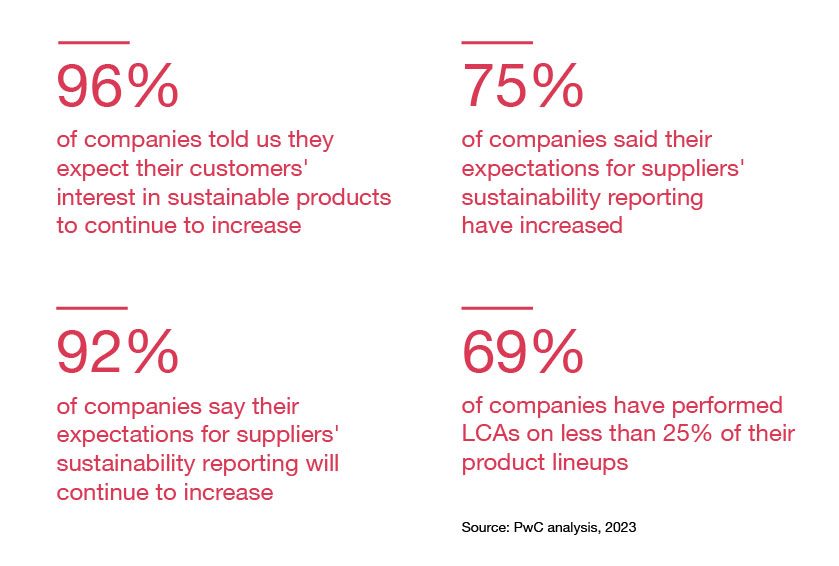This article is sponsored by PwC.
Focusing on product sustainability and producing low-carbon products yields positive results for many companies trying to keep existing customers and attract new ones. PwC research conducted on companies in multiple sectors found that 96 percent say their customers expressed an interest in the sustainability of their products and 95 percent expect this trend to continue. And while our 2023 Trust Survey showed that customer loyalty can be fleeting, a separate survey found that 80 percent of customers were willing to pay a premium for sustainable products.
In addition to increasing customer expectations, other factors are driving the focus on product sustainability. Proposed or enacted global regulations are requiring companies to disclose extensive information on how climate change is impacting their operations and what they’re doing to mitigate those risks. Your company may also have to contend with new taxes if you import carbon-intensive goods into certain markets

The path to more sustainable products and services
Increased pressures call into question the environmental impacts in each process and every step of your value chain — how products are designed and engineered; where materials are sourced; and how products are manufactured, sold and ultimately used by consumers. This is creating a bullwhip effect through supply chains as companies place similar expectations on suppliers. Our research found that more than 75 percent of respondents said their expectations for suppliers’ sustainability reporting had increased greatly over the last 12-18 months. More than 92 percent expect those expectations to continue to increase over the next year and a half.
As your company sets decarbonization goals, the management team should take a strategic approach to product sustainability at the earliest stages of product development to secure a place in this evolving market. By evaluating how customer needs are evolving and weighing that against your core strengths, you can identify opportunities to lean into its core competencies and identify opportunities to grow the top line. Some companies that have a core competency in product engineering have already started to integrate sustainability criteria and environmental impact data into their product design and development process.
Technology plays a central role in helping your company take advantage of those opportunities. The rise in customer expectations for sustainable products means companies are ingesting and sharing massive amounts of ESG data to analyze and mitigate environmental impacts across the value chain. Two processes that continue to gain prominence are a life cycle assessment (LCA) and a Product Carbon Footprint (PCF). Both help evaluate a product's emissions over its lifetime. Companies that leverage LCAs and PCFs can gain valuable insights into their operations, enabling the development of sustainable products that align with evolving market demands.
Companies feel the pressure to be more sustainable
As customers increasingly favor sustainable products, companies looking to reduce their carbon footprints are leaning on their suppliers to be more transparent about their own sustainability efforts.

What your company needs to know about life cycle assessments
LCAs help your leadership determine how to reduce the different environmental impacts of your products and services and increase the overall circularity of your value chain. LCAs represent information on a product’s environmental impacts from cradle to grave — raw material extraction, processing, product manufacturing and packaging, distribution, waste and how products are disposed of at the end of their lives. As your company gains a better understanding of the drivers of environmental impacts and attributes, you can use LCAs to help determine how a decision to cut emissions in one area of the value chain will affect other stages of the production process.
For now, companies are using LCAs on a limited basis. In a PwC analysis of LCAs, 69 percent of companies polled had performed LCAs on less than 25 percent of their product lineups. But our analysis also found that customer demands, sustainable supply chain decisions and marketing strategies are spurring rapid adoption. Company leaders are placing greater emphasis on LCAs because they provide answers to some crucial questions around which phase of a product’s life cycle produces the most emissions, how customers use and dispose of products as part of its total impact and more.
The insights gleaned from the answers can lead to your company realizing it may need to make changes, whether it’s to its processes and operations or shifting to different suppliers. That’s why PwC believes LCAs are central to the transition to more circular business models that emphasize low-carbon products and processes.
How to overcome challenges on the way to LCA adoption
The LCA process reveals powerful operational and value chain insights, but there are challenges to conducting them.
Time intensive
Almost 70 percent of the companies we polled ranked the time-intensive nature of the LCA process as their biggest challenge.
How you can overcome that challenge: As LCAs become more mainstream, the process will likely be increasingly streamlined through innovation, new digital tools and automation. Software platforms and data analytics help your company facilitate faster and more accurate LCAs, making it easier for you to conduct LCAs at scale across your product portfolio and integrate sustainability considerations into product development, marketing and decision-making processes.
Data intensive
Just over 40 percent of respondents said the availability of verified data for individual products and the complexity of the data analysis are significant obstacles.
How you can overcome that challenge: As you get more data requests from customers, consider making LCAs a central component of your ESG data reporting strategy and invest in technology that will enable you to collect and analyze data more efficiently. Some companies already use sensors in manufacturing facilities to capture real-time data. Doing this helps provide credible data that can be used to gain a greater understanding of product impacts, identify opportunities for improvement and help you communicate a product’s sustainability performance to customers and consumers. Your customers will appreciate the transparency.
Sophistication of supply chain
Vendors and suppliers may not be prepared to report the data needed to construct an LCA.
How you can overcome that challenge: Engage your suppliers on product sustainability. Research from the World Business Council for Sustainable Development done in collaboration with PwC found that on average a company’s Scope 3 emissions are 11.4 times higher than its operational emissions. For most companies, most of those emissions are associated with two categories that focus on your supply chain (purchased goods or services) and the use of your products (use of sold products). By engaging your suppliers, your company can improve the quality of data it receives and integrates into its Scope 3 inventory. Engagement may also allow you to separate suppliers that are prepared to deliver on sustainable sourcing from those that aren’t. That could be an indication of a supplier's maturity or commitment to sustainability.
The benefits of investing resources in conducting life cycle assessments
There can be significant benefits for companies that embrace LCAs. PwC research found that integrating LCAs into business operations is not only a means of compliance but also a strategic advantage. Organizations that successfully embed LCAs holistically into their processes gain valuable insights into their business partners and customers, enabling the development of more sustainable and tailored products that align with evolving market demands.
We realize the LCA process can be complex and require collaboration from teams across the enterprise. Companies should look at the LCA process as a journey. The market is looking for progress, not perfection, so your company should be comfortable conducting LCAs on a single product or product line. This can help you troubleshoot the process for any data gaps. As you engage your suppliers and the quality of data improves, you can scale your LCA process to a larger portion of your product lineup. Technology will be key to scaling and it can help you integrate LCA data into other reporting requirements.
Furthermore, your company stands to achieve secure and resilient supply chains, mitigate risks associated with resource scarcity and enable business continuity. We’ve seen that organizations that integrate LCAs into their supply chain management strategies demonstrate increased efficiency, reduced waste and improved environmental performance. By leveraging LCAs as an integral part of their strategic initiatives, these companies are able to capture the green premium associated with sustainable practices, driving potential revenue growth and fostering long-term customer loyalty.


